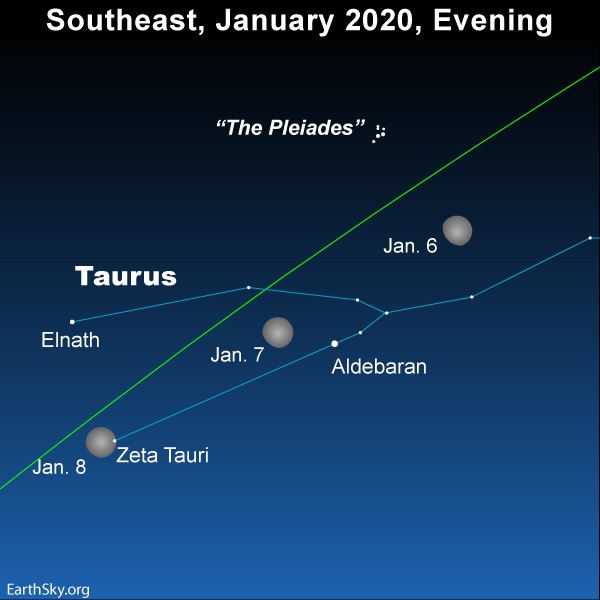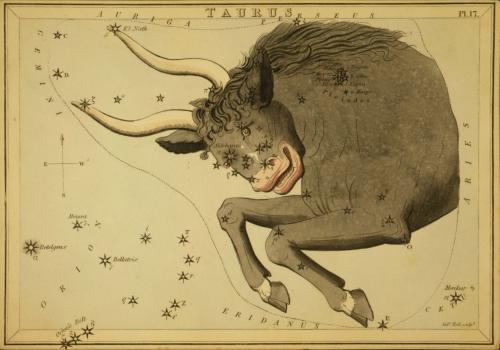
These next three nights – January 6, 7 and 8, 2020 – the bright waxing gibbous moon shines in front of the constellation Taurus the Bull. However, it will be difficult to envision the starlit figure of the Bull on these moonlit nights. Despite the lunar glare, you might see this constellation’s two major signposts: the star Aldebaran and the Pleiades star cluster, otherwise known as the Seven Sisters.

Fred Espenak – Mr. Eclipse – posted this image at EarthSky Facebook. This image is a stack of 20 individual 5-minute exposures through a Takahashi Epsilon 180ED Hyperbolic Astrograph using a Canon 6D DSLR. Photo via MrEclipse.com.
During the moon’s trek through Taurus, the moon passes to the south of the Pleiades and then to the north of Aldebaran. In fact, each month for many years to come, the moon will pass to the south of the Pleiades and to the north of Aldebaran. Yet, month by month, the moon will travel farther north in front of Taurus, until it goes so far north that it stages a series of 79 lunar occultations of Alcyone (the Pleiades’ brightest star) from September 5, 2023, until July 7, 2029.

Once the moon drops out of the evening sky, you can use the three stars of Orion’s Belt to find the star Aldebaran and the Pleiades star cluster. Image via Janne/Flickr.
What’s more, starting on September 7, 2023 (only two days after the initial occultation of Alcyone), the moon will present the first of a series of 49 monthly occultations of the star Elnath (Beta Tauri) from September 7, 2023, until April 11, 2027. Elnath, the second-brightest star in the constellation Taurus, is about half as bright as Aldebaran, Taurus’ one and only 1st-magnitude star.
Aldebaran marks the tip of a V-shaped pattern of stars – really, a star cluster – called the Hyades, representing the Bull’s face. Yet Aldebaran isn’t part of this star cluster. It’s a chance alignment, with the Hyades cluster at more than twice Aldebaran’s distance away. You’ll have an easier time seeing the V-shaped face of the Bull in the second half of he month, when the moon drops out of the evening sky.
By the way, the star Zeta Tauri is nearing the end of its present occultation series. The first of these 22 monthly occultations began on June 13, 2018, and the final occultation will take place on February 5, 2020. The next to the last occultation will happen on January 8, 2020. Yet, from virtually everywhere worldwide (except far northerly latitudes), the moon will swing just a touch north of this 3rd-magnitude star, which is a good 30 times fainter than Aldebaran.
Ruddy Aldebaran depicts the Bull’s fiery red eye, the star Elnath marks the tip of the northern horn and the star Zeta Tauri pinpoints the tip of the southern horn. After the moon and Aldebaran first pop into view at nightfall, they’ll continue (along with the other stars) to move westward as Earth spins under the sky. These two luminaries will set in the west in the wee hours after midnight.
Want to know when the moon sets in your part of the world? Visit Sunrise Sunset Calendars and remember to check the moonrise and moonset box.
Want to know in which constellation of the zodiac the moon resides? Visit Heavens-Above.

When the moon is no longer around to guide you, use Orion’s Belt to find Aldebaran. Orion’s Belt, at the lower left, always points in the direction of the constellation Taurus the Bull. The star Aldebaran resides to the south of the ecliptic whereas the Pleiades star cluster hovers to the north of the ecliptic.
The moon and Aldebaran go westward across the sky tonight for the same reason that the sun goes westward during the day. The Earth rotates from west to east on its rotational axis. So, each day, as the Earth spins full circle beneath the heavens, the sun, moon, stars and planets all appear to go across the sky from east to west daily.
At the same time, the moon is actually traveling eastward in front of the constellation Taurus the Bull at the rate of about 1/2 degree (the moon’s angular diameter) per hour. Relative to the backdrop stars of the zodiac, the moon travels on the average of about 13 degrees per day.
If you watch the moon over the next several nights, you’ll see the waxing gibbous moon farther east relative to the backdrop stars than on the previous night, as shown on the feature sky chart at top. As it moves, the moon is edging closer toward full moon, which will come on the night of January 10, 2020.

The constellation Taurus the Bull. Image via Old Book Art Image Gallery
EarthSky lunar calendars are cool! They make great gifts. Order now.
Bottom line: This evening – January 6, 2020 – the misty-looking Pleiades star cluster is found to the north of the moon, while Aldebaran, the constellation Taurus’ brightest star, shines to the east of the January 6th moon. Look for the moon to be much closer to Aldebaran on the evening of January 7, 2020.
Source:
https://earthsky.org/tonight/moon-in-taurus-on-january-6-7-and-8